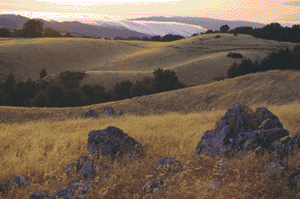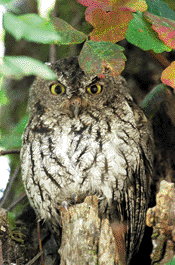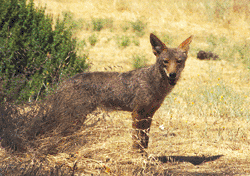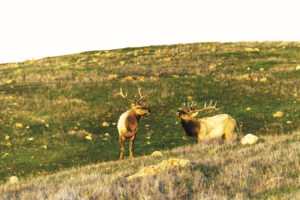The name of this preserve speaks of a time in the 19th century when Italian farmers and winemakers settled on the flanks of a ridge they named Monte Bello, or “beautiful mountain.” Dominating the skyline as seen from Palo Alto to Cupertino, Monte Bello Ridge and its high point, Black Mountain (2,800 feet), form a scenic backdrop that is unsurpassed on the Peninsula. Stevens Creek, which eventually empties into San Francisco Bay, gets its start in the shady, oak-filled canyons at the north–west end of the preserve and runs diagonally southeast the length of the preserve. There are about 15 miles of trails here, many of them linking up to trails in adjacent Midpeninsula Regional Open Space District (MROSD) preserves and county parks. Stevens Creek canyon, which you can visit on the self-guiding Stevens Creek Nature Trail and the longer Canyon Trail, is a good example of South Bay riparian habitat, complete with ferns, banana slugs, and California newts.
But Stevens Creek canyon is more than a fine riparian habitat; it is also aboveground evidence of the San Andreas Fault, the signature geologic feature of the Bay Area, which bisects the preserve, giving Monte Bello the distinction of straddling the North American and Pacific Plates and making it a worthwhile destination for those interested in geology. It also explains, in part, the diversity of plant communities found in this relatively small preserve, which, in turn, explains the diversity of wildlife that can be viewed here as well, only a few miles from the malls and office parks of Stanford and Silicon Valley. Four distinct plant communities are represented in the preserve: mixed evergreen woodland, Douglas-fir forest, chaparral, and grassland. A 6-mile loop hike through the preserve takes you through all four, as well as down a riparian canyon, up to a mountaintop, and alongside a sag pond formed in a shallow depression caused by movement along the San Andreas Fault.
- A Western screech owl in Rancho San Antonio Open Space Preserve, just southeast of Monte Bello. Photo by Yoko.
Mixed evergreen forest, which is represented here by California bay, canyon oak, coast live oak, and madrone, predominates along the first mile or so of the Stevens Creek Nature Trail as it descends into Stevens Creek canyon. The Douglas-fir forest takes over as you descend to the deeper areas of the canyon. A moderate climb that soon levels brings you to a junction with the Skid Road Trail. Here you bear left on a dirt road, once traversed by teams of oxen dragging huge Douglas-firs and smaller tanbark oaks felled by loggers. To make the going easier, the road was inlaid with flat-topped logs called skids, which were then periodically doused with water to reduce friction. In 19th-century western towns, the neighborhood frequented by loggers, which usually contained saloons, flophouses, and brothels, was often called skid road or skid row, a term that became a common phrase for such seedy neighborhoods.
Where the Skid Road Trail makes a T-junction with the Canyon Trail, you will find deciduous California buckeyes. These trees adapt to the Bay Area’s drought conditions by shedding their leaves early, often in midsummer. In early autumn, they bear the hanging fruits that give the tree its name. Later in autumn, these large buckeye balls will drop from the branches, shed their fuzzy gray-green coatings, and reveal the smooth and shiny mahogany-colored “nut” beneath.
As you come out of the canyon and climb up the southwest-facing side of Monte Bello Ridge on Indian Creek Trail, the trees recede and you enter the scrubby world of chaparral, characterized by brushier, smaller-leaved plants such as chamise, toyon, sagebrush, buckbrush, hollyleaf cherry, spiny redberry, and yerba santa. In fall, the red berries of toyon provide color to an otherwise monochromatic scene as well as food for birds.
On the way back, the route along the Old Ranch and Bella Vista Trails traverses the grasslands on scenic Monte Bello Ridge and then drops to meet the Canyon Trail. The preserve’s grasslands are great places to see spring wildflowers, such as California poppy, checker mallow, purple owl’s-clover, bluedicks, and blue-eyed grass. Throughout the year, these open areas also offer good wildlife viewing for coyote, bobcat, deer, and even mountain lions. The smaller mammals and reptiles that make their homes in the open fields regularly attract aerial predators, such as red-tailed hawks, northern harriers, and American kestrels. During fall and spring migratory seasons, wind patterns bring some less common raptors to the ridgetop, including rough-legged hawks, prairie falcons, merlins, and even occasional golden eagles. The preserve’s abundant rodent and reptile population also help make it an attractive home to a surprising variety of owl species, including great horned, barn, pygmy, long-eared, western screech, and northern saw-whet. Perhaps as surprising is the presence of Virginia rails in the vegetation around the sag ponds; these secretive birds are more commonly found in salt marshes along the Bay.

- Looking west from the field of Calera limestone boulders atop Black Mountain. Photo by Will Forney.
The ultimate objective of the loop is the summit of Black Mountain. From this lofty vantage point, you have 360-degree views that take in most of the San Francisco Bay Area, including other summits, such as Mount Tamalpais to the northwest, Mount Diablo to the northeast, Mount Hamilton to the east, and the dark green mass of Mount Umunhum to the south. San Jose, Santa Clara, and the southern half of San Francisco Bay lie at your feet. The Pacific Ocean — or the fog that often shrouds it — is visible over the crest of the Santa Cruz Mountains to the west. The San Andreas Fault, that invisible but potent player on the Bay Area stage, runs along the base of Monte Bello Ridge. Everything west of the fault is attached to the northwest-heading Pacific Plate, and rides on the Salinian Block, which is made up largely of Mesozoic-era granitic rocks, similar to those of the Sierra Nevada, and overlain by a thick cover of more recent sedimentary rocks. East of the fault, the bedrock is the Franciscan Complex, a particular assemblage of sandstones, basalt, and metamorphics that is fairly widespread throughout the Bay Area and is associated with the North American Plate. The Franciscan here is also in large part covered by sedimentary rocks, mostly of marine origin.
On the very summit of Black Mountain, however, you will find rocks that are somewhat of an anomaly in the Bay Area. This Calera limestone was probably formed on a seamount somewhere in the tropics about 100 million years ago and brought here on the Pacific Plate. The rocks contain microscopic warm-water fossils that are twice as old as those found in neighboring rocks. There is debate in the geological community as to where in the Pacific the limestone originated, but you can find it now in the form of jagged gray boulders and outcrops just southwest of the radio towers on the summit, as well as in the large Permanente Quarry downhill east of the preserve.
The human history of the area is almost as fascinating and convoluted as the geology. Until the building of the Golden Gate Bridge provided easy access to Marin County, dairies in the Santa Cruz Mountains supplied much of the milk for San Francisco and the Peninsula. There was a large dairy near what is now the preserve’s main parking area on Page Mill Road, and cattle freely grazed the slopes of Monte Bello Ridge. Ranch buildings dotted the landscape. Winemaking was also an important part of life in these hills, beginning in the late 1800s, and you can still find evidence of terraced vineyards where families grew and harvested grapes. Portuguese and Italian farmers provided much of the labor and expertise for both the dairy and the wine industry here. (The nearby Picchetti Ranch OSP contains a fine example of a historic winery.)
During the counterculture era of the late 1960s and early 1970s, the area along what is today the Canyon Trail from Page Mill Road to Indian Creek was the site of a commune called The Land. As many as 100 people took up residence and built a variety of dwellings on platforms scattered over about 700 acres of oak woodlands and secluded canyons. A large ranch building was used as a central dining hall, and other preexisting structures were used as a woodworking shop, a stained-glass workshop, and a food store selling bulk items. Commune members, many of them pacifists opposed to the Vietnam War, grew their own food in gardens, engaged in artistic pursuits, and gathered for holiday dinners and celebrations.
Unfortunately, the commune was within Palo Alto city limits, and none of the homemade dwellings complied with city building codes or zoning laws. The property, which at one time had been proposed for a residential subdivision and then a cemetery, was in the process of being sold, and the buyer and seller got into a squabble that resulted in mutual lawsuits. At one point, the seller tried to evict commune members and bulldoze their dwellings, but a mass protest stopped these actions.
The Midpeninsula Regional Open Space District, which had approached both buyer and seller, finally acquired the property in 1975, inheriting the commune and its members, who were reportedly happy that the land was being preserved as open space, but dismayed at having to leave. The District eventually evicted the people considered trespassers on public land, demolished the dwellings, and restored the area to a more natural state. This acquisition was one of the District’s most controversial to date and the rancor surrounding it lasted for several years. Time, however, proved to be a great healer.
Legends about gold and gold mining are part of California’s history, and Monte Bello has its very own story, concerning a gentleman called Indian Joe and a “ledge of gold.” MROSD general manager Craig Britton recollects, “I got a call in 1983 from a woman who said that her father knew the whereabouts of a ledge of gold [on the preserve], and he would show us where it was, if he could have half the proceeds from the sale of the gold. It was an incredible story, and I couldn’t resist the offer to meet with him and his daughter and tape his story.
“Apparently, he used to bring booze to an Indian who lived down there at Indian Cabin Creek,” says Britton. “This was at the turn of the century, and he’d take liquor and other provisions to the Indian, who paid for them with gold from turkey feathers in his headdress. He would pull out one of the feathers and tap gold dust out of the interior. It seems that every one of his feathers was full of gold dust. So he followed the old Indian one time, and there was one of those underground aquifers bubbling up, and the gold dust would just accumulate around the edges. The Indian would take his feather and fill it with the gold dust.”
Britton arranged a ranger tour of Monte Bello for the old man and his daughter, but explained that the District would never remove the gold, so it wasn’t necessary to reveal the location. The old man died not long thereafter, taking the secret of Monte Bello’s ledge of gold with him. Britton says he heard later that members of The Land commune had combed the nearby hills looking for gold but never found a speck. Names such as Indian Creek and Gold Mine Creek seem to suggest the legend has some truth, and there are those who say Indian Joe struck it rich and buried his treasure somewhere in the hills below Black Mountain.
The rest of us, however, will have to be content with the fact that the early leaders of the District had the foresight to preserve the ecological treasure that is Monte Bello Open Space so that it can now be enjoyed by everyone.

- Map by Ben Pease.
Getting There:
From I-280 in Los Altos Hills, take the Page Mill Rd./Arastra-dero Rd. exit and go southwest on Page Mill for 7.2 miles to the parking area on your left.
From the junction of Skyline Blvd. and Page Mill Rd., take Page Mill northeast 1.4 miles to the parking area on right.
Access:
Equestrians and bicyclists are allowed on all trails except the Stevens Creek Nature Trail. The first 500 feet of the Stevens Creek Nature Trail from the main parking area on Page Mill Road can accommodate a wide array of physical abilities, although it is not officially designated an easy access trail. The parking area has two designated parking spaces for the disabled and a wheelchair-accessible toilet.
Camping:
Black Mountain backpack camp atop Monte Bello Ridge has four regular campsites and one group site. Campsites are available by permit for one or two overnight stays throughout the year. Call (650)691-1200 for reservations and permits. Campers should bring a water purifier or carry their own drinking water. Campfires are prohibited.

.jpg)





